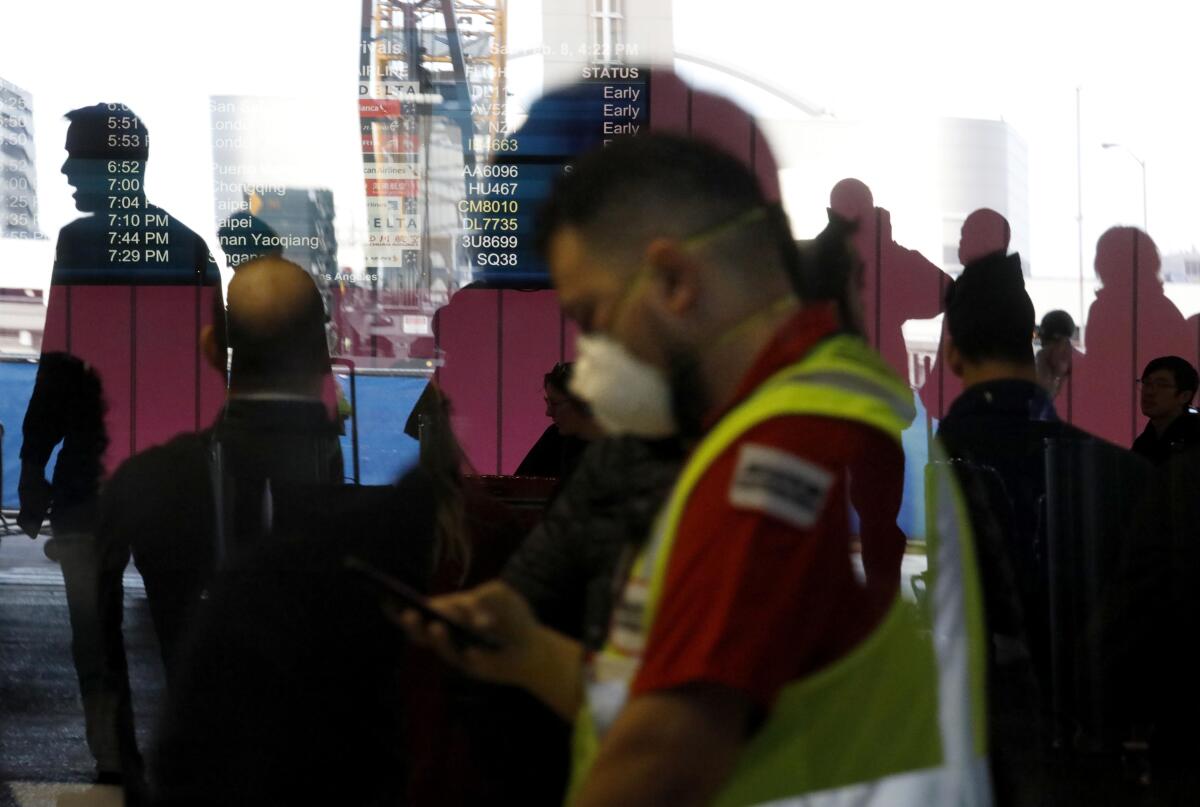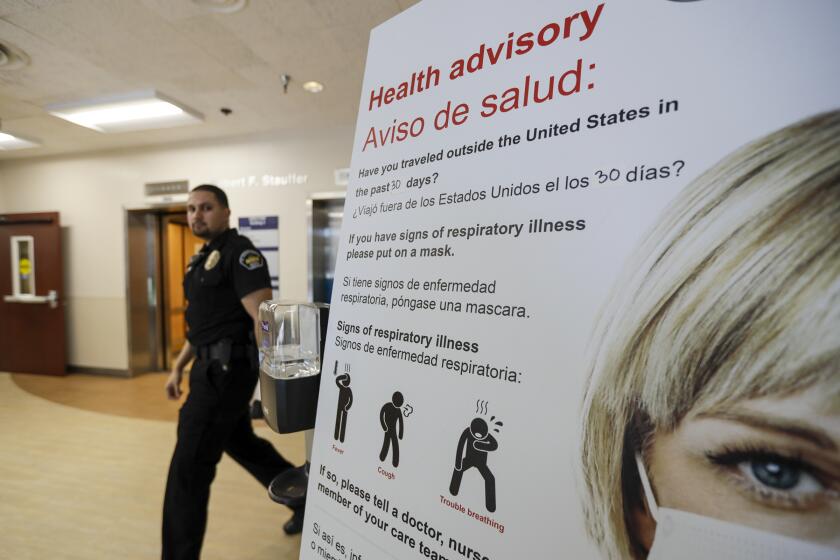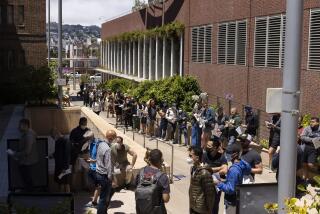California grapples with growing coronavirus threat as businesses pull out of state events

California is coming to terms with the growing threat posed by coronavirus, as two communities issued emergency orders and a patient in Northern California was described by authorities as potentially the first in the U.S. to contract the disease through community.
Officials have stressed that the number of cases in California remain low, and there are no signs of an outbreak. But health agencies said they are preparing for more cases as the virus spreads.
“Everyone’s concerned,” Gov. Gavin Newsom said.
“We’re not just preparing — we’ve been actively participating in addressing this issue for many months, aggressively,” he said. “In fact, there’s no other state in America that’s been more involved in addressing the issue.”
Newsom said that he met with Trump administration officials to discuss the coronavirus when he traveled to Washington, D.C., earlier this month to attend a National Governors Assn. meeting and added that the state continues to work closely with the federal government on the issue.
“We have had a very good relationship, open lines of communication, two-way conversations,” Newsom said. “We’re developing quite good levels of trust and continue to work through this dynamic moment. I am proud of also being a Californian, where we’re not turning our backs on people, and that’s not the case in every state in this country.”
The governor said California has been involved in monitoring and identifying individuals who have been repatriated to the state and other travelers returning independently on commercial flights.
“There hasn’t been a day since December that’s gone by where we haven’t demonstrably been engaged, and I think that’s an example of the resolve that we have to meet this moment head on,” he added. “And so rather than expressing concern, expressing anxiety, I want to demonstrate resolve to address that concern and anxiety, and I think that’s happening in all levels of government, both the county level, obviously at the state level and I couldn’t be more proud of our folks. But also I’ll say this, there’s no reason for me to say it, unless I believe it: at the federal level as well.”
Federal authorities said this week that the virus is likely to spread in the U.S.
“Ultimately, we expect we will see coronavirus spread in this country,” Nancy Messonnier, director of the CDC’s National Center for Immunization and Respiratory Diseases, said Tuesday. “It’s not so much a question of if, but a question of when.”
The warnings are already scaring away visitors and businesses to the state. On Thursday, Microsoft and Epic Games announced they were pulling out of next month’s Game Developers Conference in San Francisco.
Microsoft Game Stack said in a tweet that the decision comes after “a close review of guidance by global health authorities and out of an abundance of caution,” while Epic said that uncertainty around health concerns has made it “unviable” to send employees to the event.
Facebook followed suit, announcing that it was canceling its annual F8 Developer Conference in San Jose.
“Given the growing concerns around COVID-19, we’ve made the difficult decision to cancel the in-person component of F8 2020,” the company said in a statement. “This was a tough call to make — F8 is an incredibly important event for Facebook and it’s one of our favorite ways to celebrate all of you from around the world — but we need to prioritize the health and safety of our developer partners, employees and everyone who helps put F8 on.”
Here’s what we know about the virus and its spread in California:
What’s the reason for the Orange County emergency?
Orange County has not seen any outbreak of the illness yet. The emergency order, which was issued Wednesday, is seen as both a political statement as well as a health declaration.
Board of Supervisors Chairwoman Michelle Steel and Vice Chairman Andrew Do said at a news conference that the action is largely in response to a proposal to move coronavirus patients to a facility in Costa Mesa, which has sparked a bitter court battle. At the center of the dispute is a proposal to use the Fairview Developmental Center as a coronavirus quarantine site, an idea that drew swift and fierce condemnation from city, county, state and federal officials representing the area.
Orange County’s emergency declaration over the coronavirus comes as local officials fight a proposal to send patients to a facility in Costa Mesa.
“The county of Orange continues to support Costa Mesa in opposition of state and federal government’s decision to move COVID-19 patients to the Fairview Center,” Do said.
He and other officials say the transportation of patients into Orange County does not “preserve the health of our community,” which has a population of more than 3 million.
The city of Costa Mesa requested a temporary restraining order from a federal judge last week that blocked possible plans to send the affected individuals to the center.
On Monday, U.S. District Judge Josephine Staton ordered federal and state officials to meet with local officials from the county and Costa Mesa to answer specific questions about how the Fairview center was chosen. According to Steel, the status of the restraining order will be decided March 2.
What does an emergency declaration do?
The declaration creates a mechanism for officials to ask for mutual aid from county, state and federal partners in the event that resources are exhausted, county health officer Nichole Quick said. It allows Orange County to better leverage resources for staffing and agency coordination.
“It expands our ability to respond in a nimble and flexible way in the future,” Quick said.
There is no defined criteria, such as a certain number of coronavirus cases, for what merits an emergency declaration, Los Angeles emergency management department general manager Aram Sahakian said in a meeting with City Council members Wednesday.
“If the core group preparing for this incident feels and sees the need for additional resources and additional multi-agency coordination, they can pull the trigger on it,” he said. “It doesn’t mean it’s out of control. It doesn’t mean we’re going to panic.”
Mayor London Breed’s decree comes on the same day the CDC warns that cases of COVID-19 will continue to spread.
What about the emergency order in San Francisco?
Like in Orange County, San Francisco Mayor London Breed said the action is a precaution.
“Although there are still zero confirmed cases in San Francisco residents, the global picture is changing rapidly, and we need to step up preparedness,” Breed said in a statement Tuesday. “We see the virus spreading in new parts of the world every day, and we are taking the necessary steps to protect San Franciscans from harm.”
While three people have been treated for COVID-19 at San Francisco hospitals, there have been no confirmed cases of the illness in the city.
And in Los Angeles?
Mayor Eric Garcetti said the city is taking precautions to monitor the spread of the virus.
“The city of Los Angeles will continue to be proactive and take precautions to prevent the spread of COVID-19, and I commend our city and county response agencies for their hard work to keep us safe. My office is working closely with federal, state and county agencies to monitor the situation,” Garcetti said in a statement to The Times.
The mayor’s office said Los Angeles International Airport is also taking precautions to keep travelers and employees safe, including the use of CDC health screeners at the LAX.
Los Angeles County officials are discussing whether to declare a public health emergency, officials say. The last time the county did so was in 2017 during a hepatitis A outbreak.
The hepatitis A outbreak required extraordinary measures because the disease was difficult to contain and required widespread vaccination efforts, L.A. County health department epidemiologist Dr. Prabhu Gounder told the City Council on Wednesday. California officials also declared a state of emergency amid that outbreak.
“At the time, there was a shortage of hepatitis A vaccine. We would not have been able to get this additional vaccine for the response without the state declaration,” Gounder said.
What do we know about the Northern California case?
The individual is a resident of Solano County and is receiving medical care in Sacramento County, according to the state Department of Public Health.
UC Davis officials said the patient arrived at UC Davis Medical Center from another hospital Feb. 19. But the patient was not tested until Feb. 23.
“Upon admission, our team asked public health officials if this case could be COVID-19. We requested COVID-19 testing by the [Centers for Disease Control and Prevention], since neither Sacramento County nor the California Department of Public Health is doing testing for coronavirus at this time. Since the patient did not fit the existing CDC criteria for COVID-19, a test was not immediately administered. UC Davis Health does not control the testing process,” the medical center said in a statement.
On Feb. 23, the statement added, “the CDC ordered COVID-19 testing of the patient, and the patient was put on airborne precautions and strict contact precautions, because of our concerns about the patient’s condition.”
The positive test results came back Wednesday, the medical center said.
More to Read
Sign up for Essential California
The most important California stories and recommendations in your inbox every morning.
You may occasionally receive promotional content from the Los Angeles Times.

















